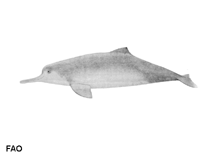Lipotes vexillifer Miller, 1918
Baiji
Classification / Names Common names | Synonyms | CoL | ITIS | WoRMS
Mammalia | Cetartiodactyla | Iniidae
Environment: milieu / climate zone / depth range / distribution range Ecology
Pelagic; potamodromous (Ref. 75906); freshwater. Subtropical; 31°N - 28°N, 112°E - 122°E
Distribution Countries | FAO areas | Ecosystems | Occurrences | Introductions
Asia - Inland Waters: China and Yangtze River.
Length at first maturity / Size / Weight / Age
Maturity: Lm 200.0 range ? - ? cm Max length : 230 cm TL male/unsexed; (Ref. 1394); 260 cm TL (female); max. published weight: 135.0 kg (Ref. 1394); max. published weight: 135.0 kg
Life cycle and mating behavior Maturity | Reproduction | Spawning | Eggs | Fecundity | Larvae
Main reference
References | Coordinator | Collaborators
Jefferson, T.A., S. Leatherwood and M.A. Webber 1993 FAO species Identification Guide: Marine Mammals of the World. Rome, FAO. 320 p. + 587 figures. (Ref. 1394)
IUCN Red List Status
(Ref. 130435: Version 2025-1)
CITES status (Ref. 108899)
CMS (Ref. 116361)
Threat to humans
Human uses
Fisheries: commercial
FAO - Fisheries: species profile | FishSource | Sea Around Us
Tools
More information
Diet composition
Food consumption
Predators
Max. ages / sizes
Length-weight rel.
Length-length rel.
Length-frequencies
Mass conversion
Abundance
Internet sources
BHL | BOLD Systems | CISTI | DiscoverLife | FAO(Fisheries: species profile; publication : search) | Fishipedia | GenBank (genome, nucleotide) | GloBI | Gomexsi | Google Books | Google Scholar | Google | PubMed | Tree of Life | Wikipedia (Go, Search) | Zoological Record



